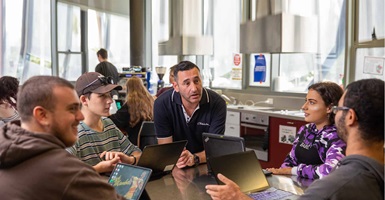In life, there are many pathways to the same destination. When it comes to your study, it’s no different.
With study pathways, you can jump into study at various points and opt out where it suits.
You can cross disciplines and gain skills in various areas, depending on your interests.
Whether you’re a school-aged student looking to take the next step at TAFE or a mature-age individual changing careers, study pathways can help you achieve your goals.
Here, we touch on three popular study pathways offered at Chisholm.
What is a study pathway?
A study pathway allows you to transition between different courses to reach an end goal.
Maybe you want to start your career while in school. A study pathway can help you do that.
Perhaps you want to do a certificate and progress to a bachelor’s degree. Again, the pathway model might suit you.
“The key element to the pathways is that they’re not completely set in stone,” Chisholm Foundation & School Pathways Associate Director Ben Jenkinson says.
“There’s a thematic approach that gives a general sense of guidance and direction to the student but allows them the flexibility to move and adjust and take up new courses and other interests as they’re working through their pathway.”
What are the benefits of study pathways?
- Flexibility – multiple ways to structure your study.
- No need for an ATAR - just follow a pathway.
- Work in your chosen industry between qualifications.
- The pathway model is not just for school leavers – anyone can follow a study pathway.
Popular pathways through Chisholm
Foundation pathways
Say you left school early or you have a particular learning need and require support with your literacy or numeracy skills. Maybe you’re new to Australia and looking to gain language skills to follow a vocational pathway.
In these scenarios, a foundation pathway could help you achieve your goals.
Foundation pathways are entry-level qualifications that enable you to gain work, life and social skills and to get into your future career pathway.
Examples of Chisholm courses that fall under this category include English as an Additional Language, Certificate I in Work Education and the Certificate I in General Education for Adults.
“We call these foundation pathways, as they build upon the foundations of educational practice to be able to engage with a pathway,” Ben says.
Secondary pathways
Chisholm offers a range of study pathway options to school-aged students.
For those who are keen to include real-world vocational learning in their study, or are not thriving in a mainstream secondary school setting, for example, there’s the option to complete the Victorian Certificate of Education at TAFE.
Some young people want to get started with their career studies as soon as possible. In this instance, Chisholm’s VET delivered to Secondary Students (VETDSS) offering may be the way to go.
With this option, you can combine VETDSS with your year 11 or 12, enabling you to pathway to an apprenticeship, employment, further study at TAFE and/or university.
There are also School-Based Apprenticeships or Traineeships (SBAT), which combine your secondary senior school studies with part-time employment and training in a trade.
Bottom line: there are many options, many pathways.
“At Chisholm, we’re very interested in pathways that enable a young person to complete their secondary school and engage with their future career interests through a study pathway,” says Ben.
Diploma to higher education
For those looking to pathway into a bachelor’s degree, there’s a relatively new pathway model being offered by Chisholm. It incorporates vocational education and higher education into one package.
Here’s how it works. With Chisholm’s pathway degrees, the first year is always a diploma and the second and third years finalise your bachelor’s degree.
What that means is you can do a one-year full-time diploma, then jump straight into a degree program.
After the next year of full-time study, you can exit with an associate degree, or you can do an additional year and exit with a bachelor’s degree.
With either option, you get a diploma and an associate degree, or a diploma and a bachelor’s degree – all within about three years!
“Essentially, we’re not applying credit backwards – we don’t work like that,” says Chisholm Higher Education College Dean Dr Ben Allitt. “We just consider the diploma the first year of our degree program.”
Which degrees are applicable?
The pathway model is offered in some form or another through Chisholm’s following degree programs:
- Bachelor of Psychology
- Bachelor of Nursing (with La Trobe University)
- Bachelor of Business
- Bachelor of Engineering Technology
- Bachelor of Community Mental Health, Alcohol and Other Drugs
- Bachelor of Education - Chisholm/Federation University
Benefits of diploma to higher education pathway
Dr Allitt says there are all sorts of perks to this type of study.
“The pathway is structured so that there are multiple opt-in and opt-out points,” he says. “You could do a certificate IV, go on to do a diploma and then go on to do a degree.
“It gives students multiple options in how they want to structure their study. They can do the diploma and leave, or come back and do the associate degree, or the entire bachelor’s degree. It’s very, very flexible.
“To follow this pathway, you don’t need an ATAR. Our motto is ‘no ATAR, no worries’.
“Through the pathway model, you can study at any level you like through the Chisholm programs we offer. They are accredited, nationally recognised, and give students options that they might not have had before.”
Dr Allitt says another key benefit is that students can work in their chosen industry between qualifications.
“The diploma gives you a certified qualification and opens doors for certain careers. Because of our flexible options, students can study with us full-time and be working and upskilling at the same time.”
What’s really great is that the pathway model is not just for school leavers.
“Anyone who wants to change careers, upskill or just do it for interest, are welcome with us,” says Dr Allitt. “Barely anybody stays in the same job for their entire life. You need multiple skillsets – it’s essential for the modern career.”
Dr Allitt says you can also do companion training to bolster skills in different areas.
“With our Bachelor of Business, you can do a diploma in anything,” he says. “You could do a diploma in construction or engineering, for example, and then go straight into the second year of the Bachelor of Business.”
“This gives students the option to have multiple skillsets, so they’re not tied down to one stream or discipline. They can cross disciplines, get multiple qualifications and within the same timeframe (three years) still get a degree.”
Free TAFE pathways
In 2023, the Free TAFE Pathways initiative was introduced.
Free TAFE pathways allow you to achieve multiple qualifications in a selected pathway for free. The program is available to students who have first completed a course in a designated Free TAFE Pathway (at Chisholm or an alternate provider) and are now looking to undertake a course in the same industry area.
If you’ve already completed a Free TAFE course that is now featured in the Free TAFE Pathways initiative, you can now access additional free TAFE courses in the same pathway.
As part of the Free TAFE Pathway program, Chisholm offers courses in the following industry fields:
- Accounting
- Allied heath and nursing
- Building and construction
- Community services
- Dental
- Early childhood
- Education support
- Information technology
- Nursing and personal care
Visit the Free TAFE pathways for eligibility information, courses included and more.
Like to know more?
These are just a few examples of pathways offered by Chisholm – there are many others.
To find out more about how a pathway could work for you visit chisholm.edu.au/pathways.


